Lecture 2Non-verbal Communication
《Non-verbal Communication》 学历案
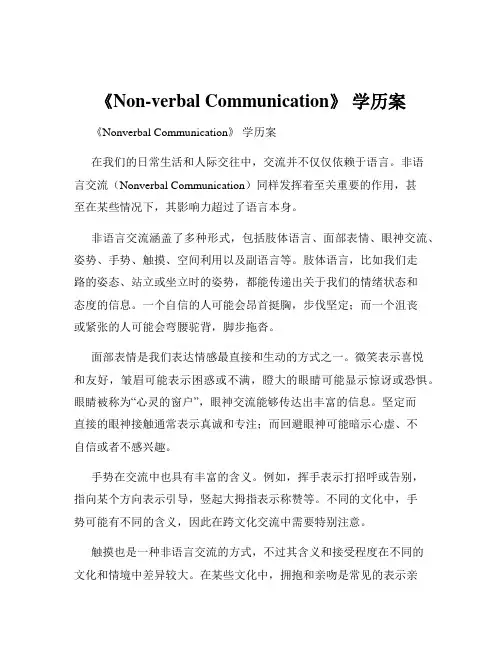
《Non-verbal Communication》学历案《Nonverbal Communication》学历案在我们的日常生活和人际交往中,交流并不仅仅依赖于语言。
非语言交流(Nonverbal Communication)同样发挥着至关重要的作用,甚至在某些情况下,其影响力超过了语言本身。
非语言交流涵盖了多种形式,包括肢体语言、面部表情、眼神交流、姿势、手势、触摸、空间利用以及副语言等。
肢体语言,比如我们走路的姿态、站立或坐立时的姿势,都能传递出关于我们的情绪状态和态度的信息。
一个自信的人可能会昂首挺胸,步伐坚定;而一个沮丧或紧张的人可能会弯腰驼背,脚步拖沓。
面部表情是我们表达情感最直接和生动的方式之一。
微笑表示喜悦和友好,皱眉可能表示困惑或不满,瞪大的眼睛可能显示惊讶或恐惧。
眼睛被称为“心灵的窗户”,眼神交流能够传达出丰富的信息。
坚定而直接的眼神接触通常表示真诚和专注;而回避眼神可能暗示心虚、不自信或者不感兴趣。
手势在交流中也具有丰富的含义。
例如,挥手表示打招呼或告别,指向某个方向表示引导,竖起大拇指表示称赞等。
不同的文化中,手势可能有不同的含义,因此在跨文化交流中需要特别注意。
触摸也是一种非语言交流的方式,不过其含义和接受程度在不同的文化和情境中差异较大。
在某些文化中,拥抱和亲吻是常见的表示亲密和友好的方式;而在另一些文化中,这样的触摸可能被视为过于亲密或不适当。
空间利用也能反映出人与人之间的关系和交流的意图。
例如,在与亲密的朋友交流时,我们可能会站得比较近;而在与陌生人交流时,通常会保持一定的距离。
副语言包括声音的语调、语速、音量和停顿等。
同样的一句话,用不同的语调、语速说出来,传达的意思可能完全不同。
比如,快速而大声地说话可能表示激动或愤怒;缓慢而轻柔的语调可能表示安慰或亲密。
非语言交流在很多方面都具有独特的优势。
首先,它往往比语言更难以伪装。
尽管人们可以控制自己说的话,但非语言信号通常是下意识的反应,更能真实地反映内心的感受和想法。
nonverbalcommunication非言语交际PPT
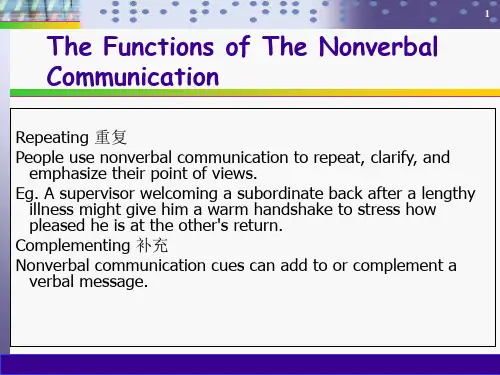
Spatial Use and Time
苏安梅
华南农业大学外国语学院
6
Appearance
Appearance (clothes, hairstyle, makeup, personal decoration) may indicate mood, occupation, culture, status, or group membership, character.
What are the comfortable distance between you and your close friends, between you and your teacher, between you and your classmate, between you and a stranger?
苏安梅
华南农业大学外国语学院
7
苏安梅
华南农业大学外国语学院
8
Posture
Posture refers to your body’s position as you sit or stand, which communicates a great deal about your mood or feelings.
under discussion Eg. A person pounding on a desk as she makes an important
point.
苏安梅
华南农业大学外国语学院
4
I hate my job. I am so bored.
苏安梅
பைடு நூலகம்华南农业大学外国语学院
5
Elements of Nonverbal Communication
跨文化交际 Lecture-2-NONVERBAL-1

52-
17
Where to sit?
52-
18
Facial expression
Look at the following pictures, try to tell which people is…
1. The most kind-hearted? 2. The most artistic? 3. The most smart?
5220
Eye contact in different countries
• Generally speaking, southern Europeans have more frequent eye contacts than Northern Europeans and Americans; • Italians may regard British men as cold, while the British may think Italians are very warm-hearted; • But these may NOT be true!
1.1 Body Language
《Non-verbal Communication》 讲义
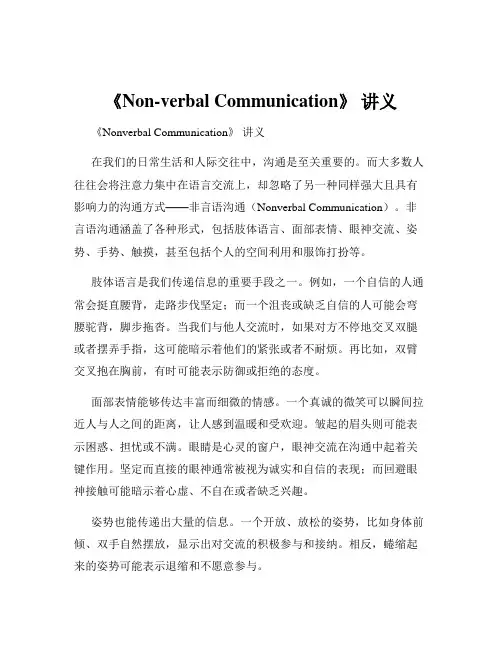
《Non-verbal Communication》讲义《Nonverbal Communication》讲义在我们的日常生活和人际交往中,沟通是至关重要的。
而大多数人往往会将注意力集中在语言交流上,却忽略了另一种同样强大且具有影响力的沟通方式——非言语沟通(Nonverbal Communication)。
非言语沟通涵盖了各种形式,包括肢体语言、面部表情、眼神交流、姿势、手势、触摸,甚至包括个人的空间利用和服饰打扮等。
肢体语言是我们传递信息的重要手段之一。
例如,一个自信的人通常会挺直腰背,走路步伐坚定;而一个沮丧或缺乏自信的人可能会弯腰驼背,脚步拖沓。
当我们与他人交流时,如果对方不停地交叉双腿或者摆弄手指,这可能暗示着他们的紧张或者不耐烦。
再比如,双臂交叉抱在胸前,有时可能表示防御或拒绝的态度。
面部表情能够传达丰富而细微的情感。
一个真诚的微笑可以瞬间拉近人与人之间的距离,让人感到温暖和受欢迎。
皱起的眉头则可能表示困惑、担忧或不满。
眼睛是心灵的窗户,眼神交流在沟通中起着关键作用。
坚定而直接的眼神通常被视为诚实和自信的表现;而回避眼神接触可能暗示着心虚、不自在或者缺乏兴趣。
姿势也能传递出大量的信息。
一个开放、放松的姿势,比如身体前倾、双手自然摆放,显示出对交流的积极参与和接纳。
相反,蜷缩起来的姿势可能表示退缩和不愿意参与。
手势可以强化我们的言语表达。
在描述某个大小时,用手比划可以让对方更直观地理解。
但需要注意的是,不同的文化中,某些手势可能具有完全不同的含义。
比如,在某些国家,竖起大拇指表示赞赏;而在另一些国家,可能是一种不礼貌的手势。
触摸是一种非常亲密和有力的非言语沟通方式。
轻轻的拍肩可以表示安慰和鼓励;握手的力度和方式也能传达出不同的情感和态度。
然而,触摸的方式和程度必须根据关系的亲疏和文化背景来把握,否则可能会引起不适或误解。
个人的空间利用也在非言语沟通中扮演着角色。
每个人都有自己的“个人空间泡泡”,当他人侵入这个空间时,我们可能会感到不舒服或有压力。
Nonverbal Communication 非语言交际 ppt课件
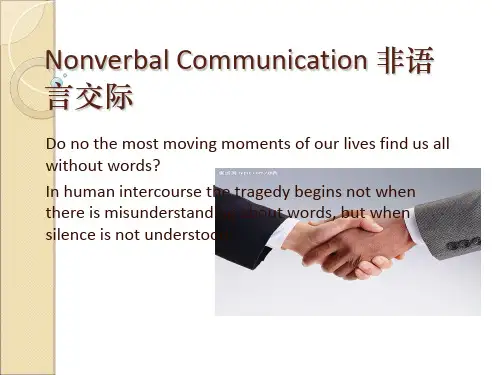
非语言交流Defining Nonverbal Communication
非语言交流涵盖了某种交流情景下的所有非语言刺激因素,这些刺 激因素是通过信源以及对环境的利用产生的,并且对信源或信宿具 有潜在的信息价值。
Nonverbal communication involves all those nonverbal stimuli in a communication setting that are generated by both the source and his or her use of the environment and that have potential message value for the source or receiver.
夸大差异。在宋朝,伸舌头表示假装害怕,而伸舌头在外表示 惊讶,这一话题足以使鸡尾酒会的人们喋喋不休,说个没完。
非语言交流与文化。全世界的人们都有同样的基本感情(恐惧、 兴奋、气愤、惊讶、厌恶和悲哀)。但是在涉及什么事情会引 起某一情感,人们在什么地方、以什么方式表达感情,以及人 们如何界定情感等方面,都因文化而异。
“观其壳可知其核(By the husk you may judge the nut)。” 大多数美国人认为,壳应该是完美无瑕的。许多人意识到,由 性别、衣服样式、种族、年龄、民族、身份、体形、情绪等外 化出来的表象来反映某人的基本特征。研究表明:在美国,肥 胖者收入低,结婚率低,受教育程度低。我们根据一个人的魅 力、着装以及个人小饰品对其“知识、性别、年龄、亲和力、 财政状况、阶层、品味、价值观和文化背景等”。魅力迷恋在 文化中已根深蒂固,即便小孩也更愿意选择与漂亮的小朋友为 伴。
2 nonverbal communication
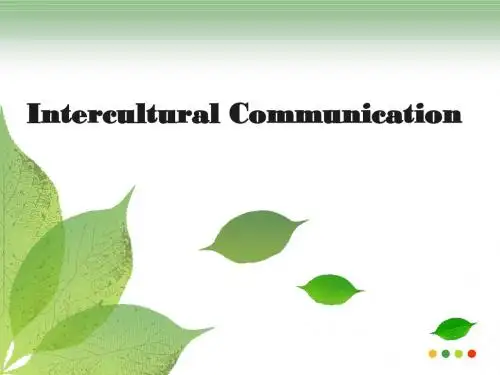
e.
f. g.
1. Posture People's social status, religious practices, feelings of submissiveness, desires to maintain social distance. a. b. c. d. Confident people: relaxed posture, stand erect with shoulders back and head up and walk with assurance. Lack of assurance and confidence: walk with stooped shoulders and a slow, hesitating gait. Goal oriented: walking rapidly and swinging the arms. A preoccupied walk: hands clasped behind and head lowered, thoughtful.
Simply speaking, it refers to communication without the use of words. words.
According to two different researches:
2. Why is nonverbal communication important?
1. Posture
d.
Thailand: the bottoms of the feet are the lowest part of the body, they should never be pointed in the direction of another person. U. S. & Britain: lean back in chairs and put feet on desk to convey a relaxed, informal attitude. Middle East, Swiss and Germany: putting feet on desk is rude. Japan: sit quietly.
Unit 2 Non-verbal Communication 课件 1-优质公开课-重大版高中选修8精品
根据下文完成下列各题 1.Fill in the form Body language waving one’ s hand a smile and handshake clapping hands nodding the head shaking the head The meanings
bye (1) to say good(2) welcome (3) congratulations (4) agreement (5) disagreement
[语境助记] (1)I think we can safely assume that this situation will continue. 我想我们可以有把握地认为这种情况将持续下去。 (2)We must assume him to be innocent until he is proved guilty. 在证实他有罪之前我们必须要假定他是清白的。 (3)Assuming that he’s still alive, how old would he be now? 假定他还活着,现在有多大年纪了?
[题组训练] (1)用适当的介、副词填空 ①You can turn to trouble. ②Those who want to go are to turn before Friday. ③Don’t worry.All will turn out ④Please turn the radio homework. ⑤We arranged to meet at 7∶30,but she never turned up . right. a bit.I’m doing my your teacher for help if you are in
1.In the crowded room, the boy and the girl steal glances at each other, turning their eyes away when their eyes meet. 在一个拥挤的房间里,一个男孩和一个女孩相互窥视,当四 目相对时又把目光移开。 [归纳拓展] turn away 回绝,把„„打发走;转 (或背 )过脸去 turn up 出现,到场,露面;开大(音量) turn down 拒绝;把„„调小 turn in 上交 turn on/off 打开/关上 turn over 翻转;移交 turn to 转向;求助于 turn out 证明是,结果是;生产,制造
Nonverbal Communication 非语言交际 ppt课件
与男性比,女性双臂更紧抱胸前,有异性在场时,双腿仅靠很少交叉。
手势
在美国,人们用食指去指东西,甚至是指人;德国人用小拇 指;日本人用整只手,而且手掌向上。
在阿根廷,人们捻想象的胡须表示“一切顺利”。在美国大 拇指和食指交叉成圆,其他手指伸开,象征 “OK”这个词 在日本这个手势指“钱”;在阿拉伯国家,这种手势伴随着 咬牙的动作,表示深恶痛绝;在墨西哥和德国,它有猥亵的 含义;在突尼斯意味着“我杀了你”。
日本:鞠躬不仅是问候,它还表示了该文化对地位和等级的重视。地 位低的人先向地位高的人鞠躬,角度还要比后者低。地位高的人决定 何时鞠躬完毕,双方地位相同时,他们同时鞠躬同时起身。
美国人和加拿大人崇尚随意和友好,人们常随便地坐在椅子里或随意 地站着。在德国、瑞典国家,生活方式就不那么随意,无精打采地站 着是粗鲁、不礼貌的行为。在比利时,双手插兜里是不尊敬他人的表 现。
眨眼(很快的合上一只眼,微微一 表示下列几种感情:会意,赞许,
笑点点头)
鼓励,传递信息,表示团结等
面部表情Facial Expression
面孔是心灵的镜子;面孔能泄密。
每个人都有相似的表情,但人们赋予它们的文化含义却因文化不 同而不同。
文化无法控制面孔 – 全世界有一套基本的面部表情,其中至少有 六种都是与生俱来的,具有普遍性,基本含义相同。这些泛文化、 普遍的六种面部表情就是快乐、悲哀、恐惧、气愤、厌恶和惊讶。
身体动作
运动信号指的是那些看得见、能发出信息的身体变动。这些信息关于: 你对他人的态度(与朋友面对面站着,或身体向前微倾,表明你很放 松);你的情感状况(敲桌子表明你紧张);你控制环境的欲望(示 意某人走过来意味着你想同他交谈)。
chapter 2 Nonverbal Communication
Chapter 2 Nonverbal Communication●What is nonverbal communication?“Oral and nonoral messages expressed by other than linguistic means.”●Types of Nonverbal Communication1. Body Behavior2. Voice3. Time and Space4. Facial Expression5. Eye Contact6. Posture7. Gestures8. Touch9. Paralanguage●Characteristics of nonverbal communicationsThe nonverbal communication can be unintentional.A nonverbal communication may be more honest than a verbal one. Nonverbal communication makes, or helps to make, a first impression.Nonverbal communication is always present.●Nonverbal communication serves many functions:✓RepeatsNonverbal communication can reinforce what is said in verbal language.✓SubstitutesNonverbal behavior can be used to replace verbal behavior to convey certain meaning.✓AccentsThe accompanying nonverbal behavior very often can add force to the verbal message.✓RegulatesNonverbal communication very often functions to regulate the flow of the verbal interaction.✓ContradictsNonverbal behavior often betrays the speaker by sending contradictory messages to the verbal codes.●Nonverbal Communication Ithe importance of “first impression”Before someone processes our verbal messages,She has taken in our appearance,Registered our enthusiasm and sinceretyNoted our tone of voice and processed all into nonverbal message.●Nonverbal Communication II•If this message reinforce the content of verbal one, it means we send a powerful message.•If the two messages do not match, they may cancel each other and that means no messages delivered.•Nonverbal communication part of this training is for learning how to create a powerfull nonverbal message that will support your verbal content.●Projecting a Powerful Image IHow would you like to sound?How would you like to look?How did you look &sound ?The name of the difference is the “image gap”improves your ability to develop trust &rapport●Projecting a Powerful Image IITotal image consists of:•The first impressions you project•The depth of your knowledge•The breadth of your knowledge•Your enthusiasm.●First Impression IIPositive first impression make communications much easier and more comfortable.Negative first impressions can cut off a relationship before it gets started.●First Impression III✓Accent✓Monotone and weak voice, poor vocabulary✓Cold, limp handshake✓Lower quality, with inappropriate coloures, messy dressing style, dirty shoes✓Seldom eyecontact✓Poor posture, bad hygiene creates a barrier.●Depth of Knowledge IDepth of knowledge: in the area of expertise•This refers how well you know your subject?•How well do you know your company?As a part of your image, learn your job, company, industry, firm’s policies, personnel●Breadth of Knowledge IBreadth of Knowledge:This area deals with your ability to converse with others in fields of outside area of expertise.By increasing the breadth of your knowledge, you will be able to develop rapport with others.Most people like to work with others who are enthusiastic about their work.Enthusiastic people seem to work harder, longer and more accurately than those who are not enthusiastic.●Projecting a Powerfull Image IIIThe response you receive from the world around you is a measure of your success in interpersonal relations.Every word, gesture, expression and impression is being seen and evaluatedTherefore be careful and respectful generally.●Language of GesturesBody language and nonverbal communication are transmitted through the eyes, face, hands, arms, legs and posture (sitting and walking)●Eyes IHonest person has a tendency to look you straight in the eye when speaking.At least listeners accept it like that.●Eyes IIPeople avoid eye contact with other person when an uncomfortable question asked.The raising of one eyebrow shows disbelief and two shows surprise.●The Face IThe face is one of the most reliable indicators of a person’s attitudes, emotions & feelingsBy analysing facial expressions, interpersonal attitudes can be discerned and feedback obtained.Common facial gestures are:Frowns: unhappiness, angerSmiles: happinessSneers: dislike, disgustClenched jaws: tension, angerPouting lips: sadness.●The Hands ITightly clenched hands usually indicate that the person is experiencing undue pressure.It may be difficult to relate to this person because of his tension and disagreement.●The Hands IIRubing gently behind or beside the ear with the index finger or rubbing the eye usually means the other person is uncertain about what you are saying.Leaning back with both hands supporting the head usually indicates a feeling of confidence or superiority.●The Hands IIICupping one or both hands over the mouth, especially when talking, may well indicate that the person is trying to hide somethingFingers bent across the chin or below the mouth most often shows critical evaluation.●The Arms and Legs ICrossed arms tend to signal defensiveness.Conversely, arms open and extended toward you generally indicate openness and acceptance.●The Arms and Legs IIPeople who tightly cross their legs seem to be saying that they disagree with what you are saying or doing.If the people have tightly crossed legs and tightly crossed arms, It may be difficult to get agreement.●Interpreting Gesture ClustersCertain combinations of gestures are especially reliable indicators of a person’s true feelings. These combinations are clusters.●Common Gesture ClustersOpenness:Several gestures indicate openness and sincerety•Open hands,•unbuttoned collar,•leaning slightly forward in the chair,•removing coat or jacket,•uncrossing arms and legs,•moving closer.●Common Gesture ClustersDefensiveness:Several gestures indicate defensive•a rigid body,•arms or legs tightly crossed,•eyes glancing sideways or darting occasionaly.•minimal eye contact•lips pursed, fists clenched and downcast head●Common Gesture ClustersEvaluation:Several gestures indicate evaluation•tilted head•hand to cheek•leaning forward•chin stroking●Suspicion, Secrecy, Rejection, and Doubt:These negative emotions are communicated typically by: •Sideways glances•Minimal or no eye contact•Shifting the body away from the speaker•Touching or rubbing the nose.●Potential benefits of non-verbal communication1、Rapid communication of messages2、Simplification of complex messages3、Securing audience attention4、Making messages memorable (visual hook)5、Persuading and motivating1. Rapid communication of messages•Signs used on roads and motorways2. Simplification of complex messages•Showing conceptual or spatial relationships3. Securing audience attention•Dramatic or unexpected images in advertisements4. Making messages memorable (visual hook)•E.g. NIKE●Potential problems with visual media•Inconsistency –a particular ‘picture’ may not be consistent with other aspects of the message that is being sent •Inherent unsuitability – it may not be suitable for the receiver that the sender is trying to reach•Context-related meaning –its meaning may be altered according to the context in which it is being received●Presenting data visually•tables•pie charts•bar charts•line graphs•maps•flowcharts●SummaryOrganisations make use of a wide range of non-verbal signals, including visual images.There are many potential advantages of non-verbal encoding: messages are quickly assimilated; complex content can be simplified; the attention of an audience can be caught and messages can be more memorable. In addition, images are often powerful persuaders and motivators.●Summary (continued)The most common problems arise when pictures of all kinds are used carelessly (i.e. images are either inconsistent, inherently unsuitable or inappropriate in a particular context).Graphs and charts can be used to present data in more informative and appealing ways. However, it is important to use the most appropriate type and format, ensuring that you communicate a clear and undistorted impression of the underlying figures.。
non-verbal communication 无语言交流(课堂PPT)
.
29
Hands
• Clapping to indicate applause
unintentional
• Ambiguous
• Primary
• Continuous
• Multi-channeled
.
11
Functions of Nonverbal Communication
• To provide information • To regulate interaction • To express or hide emotion and affect • To present an image • To express power and control
.
23
Time
• Time is a conception, a culture, and ways of life.
• Different cultures have different interpretation and conception of time.
• Americans say that he who hesitates is lost, while we Chinese often say that think three times before you act. (Think twice before you leap.)
.
7
Definition: (1)
• “Metacommunication (beyond
the usual commmunication),
paralinguistics, second-
order messages, the silent
- 1、下载文档前请自行甄别文档内容的完整性,平台不提供额外的编辑、内容补充、找答案等附加服务。
- 2、"仅部分预览"的文档,不可在线预览部分如存在完整性等问题,可反馈申请退款(可完整预览的文档不适用该条件!)。
- 3、如文档侵犯您的权益,请联系客服反馈,我们会尽快为您处理(人工客服工作时间:9:00-18:30)。
4. Kin部禁忌动作:中英双方都禁忌在大庭广众 面前用手指在自己或别人身上乱捅乱摸。所以, 当众抠抠眼睛、掏掏耳朵、挖挖鼻孔或掏掏嘴等 动作都是忌讳的。另外,像梳头,除头垢、头皮, 清除牙垢,冲洗假牙,挤压粉刺,清洗指甲心儿, 修剪指甲,装取隐形镜片,擦脂抹粉,整理服饰 等等动作,也都禁忌在大庭广众之中进行。优雅 的举止还要求避免身体抽搐,手指捻动,乱抓乱 动,不在别人身上掸灰拣毛,不用手指戳别人胸 脯。这些动作也都是中英双方禁忌的。
4. Kinesics—Facial expressions
4. Kinesics—Facial expressions
• According to Ekman & Frisen (1975) there are six basic emotions: surprise, fear, disgust, anger, happiness, and sadness.
4. Kinesics—Postures
• 在东方人眼里,美国女子大胆 而泼辣,因为他们的步子比东 方女子大,腰板挺的更直。在 西方人眼里,日本女子的莲莲 碎步反映出他们的柔顺和屈从 心理。 • 英国人将两臂交叉放在胸前表 示旁观或不准介入,恰似中国 的“袖手旁观”;美国人着重 随意与潇洒的个性,常常大大 咧咧的坐下来或者站着时一副 松松散散的样子。教师讲课时 可以坐在讲台上,经理或老板 在自己办公室里可以将双脚放 在桌子上。但在德国等欧洲国 家,生活方式比较规范,人们 十分注重礼仪,懒散的样子常 被认为是粗俗和无礼的标记。
4. Kinesics—Gestures
• 10) On Top The person who grasps your hand with their palm down, and yours beneath their palm, feels confident, superior and is trying to dominate you. • 11) Two-hand People who grasp your hand with both of theirs want you to think they're honest and trustworthy. This is also a type of handshake used by people who have a warm and friendly attitude towards the person they are shaking hands with.
4. Kinesics—Gestures
• 2) Patting a child’s head, but not a teenager or adult’s head -- In China, it shows affection, otherwise might cause offense. -- In Britain or America, it means giving comfort, consolation or encouragement between close friends. -- In India, Sri Lanka and Thailand, it would be shocking and offensive, as the head is believed to be the seat of the soul.
4. Kinesics—Gestures
• The following gestures with the hand are different ways a person will initiate or respond in a handshake, and the meaning behind that gesture in the West. • 9) Fingertip Flitter(指尖掠过) • If a person just makes a grab for your fingers, they are insecure and wish to keep you at a distance.
4. Kinesics—Postures
• You can tell a lot about someone just from watching their posture.
4. Kinesics—Postures
• 姿势指的是身体呈现的样子,包括立、坐、卧、蹲、跪、 跑、走等。著名人类学家格登· 休斯(Gordon Hewes)研 究了多种文化的姿势以后发现人类姿势多达一千多种。不 过,研究人员一般将姿势分成三类:立姿(standing)、 曲姿(bent-knee position,坐、蹲、跪等)和卧姿 (lying)。此外,姿势还可以看成是身势动作的延伸或 作为调整自己与别的人或物之间距离的一种方法。 • 人类基本姿势大致相同或相似。但是,隶属于不同文化的 人都有自己独特的奔跑、行走、站立、蹲跪和坐卧的特点。 在跨文化交际中,这些不同的特点有时会造成交际障碍和 文化冲突。
4. Kinesics—Gestures
• 1) Offering or accepting a gift -- In China, both hands are used to show respect. -- In Britain or America, one hand is used, and can be either hand; unless the gift is too large or heavy, then both hands are. -- In Muslim countries, only use the right hand, or both hands, never the left hand which is considered unclean.
4. Kinesics—Gestures
• 4) the thumbs-up gesture • -- widely understood to “okay” in the United States or used by hitchhikers to ask for a free ride, • -- in Greece and Sardinia (An island of Italy in the Mediterranean Sea): the idea of showing contempt or rejection. • --in Australia, Iran, and Nigeria: similar obscene connotations.
NONVERBAL COMMUNICATION
4. Kinesics/Body Language (举止神态学)
4. Kinesics
• Kinesics, or body language, is one of the most powerful ways that humans can communicate nonverbally. It's used to portray moods and emotions, and can emphasize or contradict what is being said. • Body language contains 1) gestures手势, 2)postures体态, 3)facial expressions面部表情, 4)eye contact目光接触.
4. Kinesics—Gestures
• 5) Palm up, the single finger or fingers more or less together and moving toward his or herbody to beckon: -- in China, Yugoslavia, Vietnam and Malaysia beckoning animals -- in Indonesia and Australia for prostitutes --in the U.S.—to call a person • Filipinos often summon someone with a quick downward nod of head. • In Germany and much of Scandinavia, a beckoning motion is made by tossing the head back.
4. Kinesics—Gestures
4. Kinesics—Gestures
• Gestures can be particularly troublesome, for a slight difference in making the gesture itself can mean something quite different from that intended. A wrong interpretation of a gesture can arouse quite unexpected reactions.
4. Kinesics—Postures
• 姿态动作的幅度和速度以及姿势和坐立习 惯地反映出不同的文化背景和心态。 • 犹太人的手部动作远比一般德国人的手部 动作来的自由,所以二战时期生活在德国 境内的犹太人要尽量控制自己的手部动作, 以免暴露身份。 • 白人中的年轻人步履轻捷,而年轻的黑人 则步伐较慢,这与他们的社会环境不无关 系。
4. Kinesics—Gestures
• 3) The ring gesture. (The tip of the thumb and the tip of a finger meeting to create a ring.) -- in America - “OK” -- in Japan, Korea“money” -- in France -“zero or worthless” -- in Brazil: it’s more offensive than the raised middle finger.
